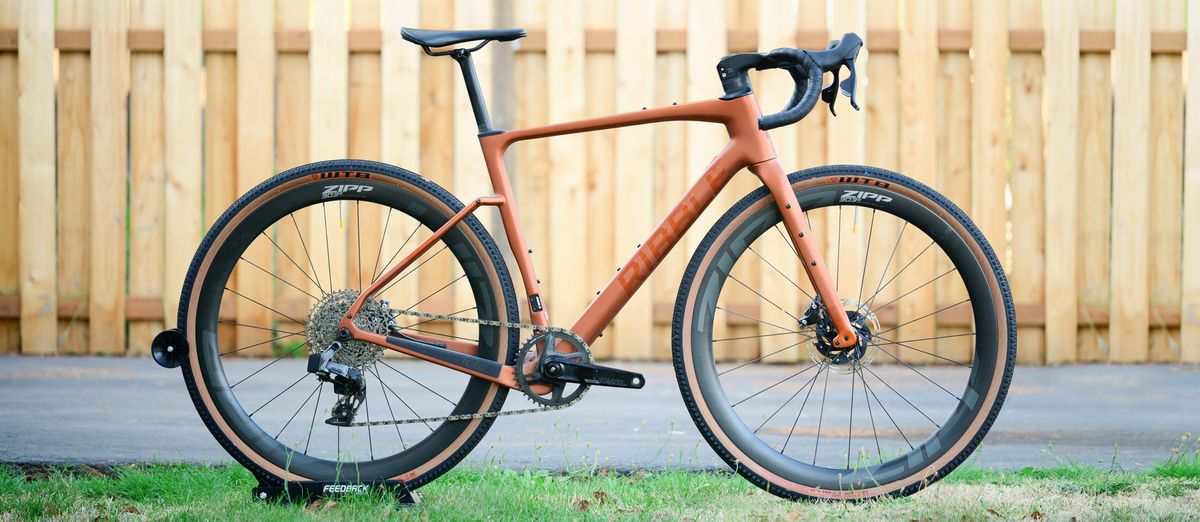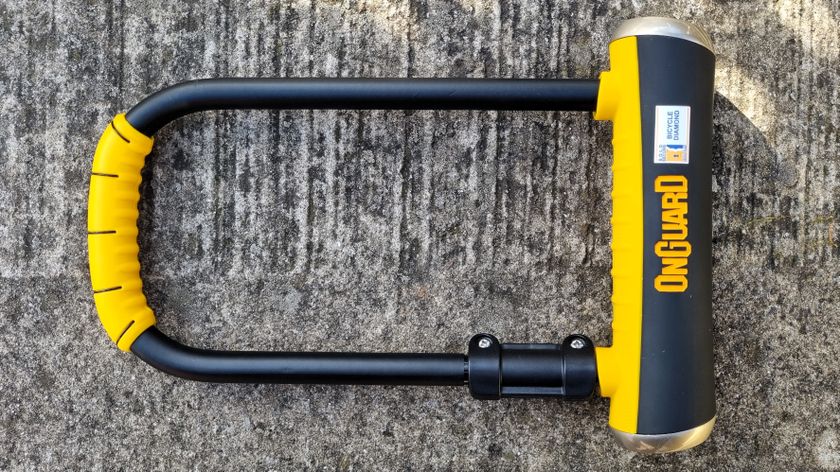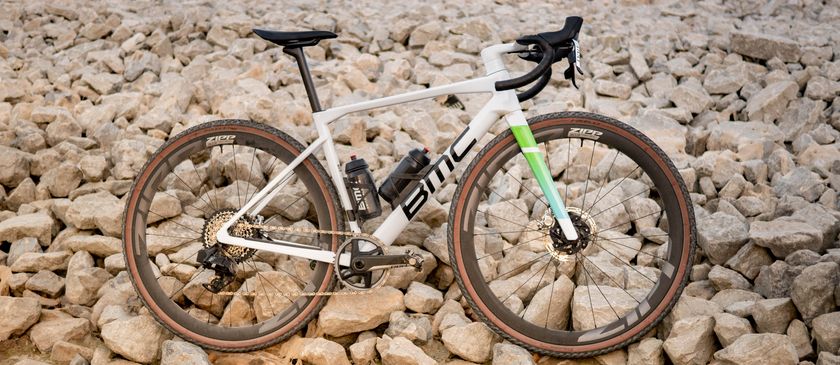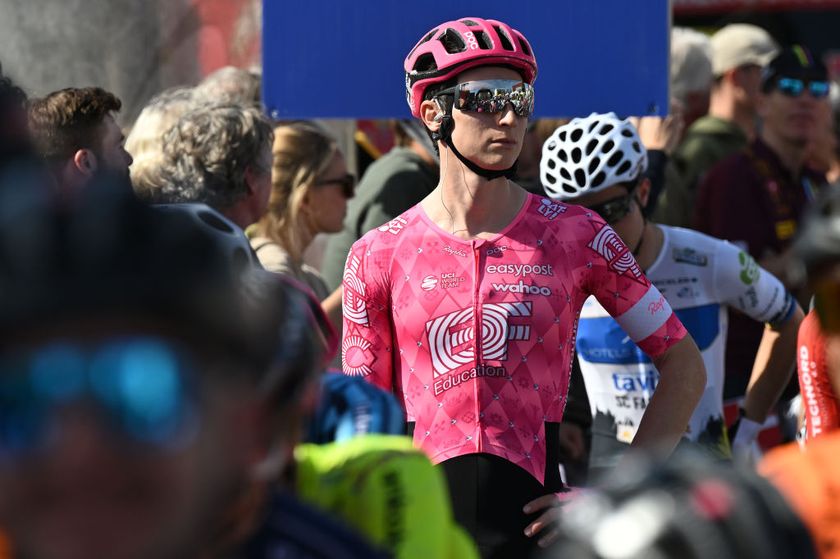Cyclingnews Verdict
The Gravel SL is, like many race-focused gravel bikes, an excellent all-around choice. There are some unfortunate limitations to the build options but the biggest problem for Ribble is the competition. Both Canyon and Ventum now have comparable bikes that are either the same price with more choice or less expensive.
Pros
- +
Some customisation when ordering
- +
Mudguard/Fender mounts
- +
Compatibility with 650b and 700c wheels
- +
Room for 700x45mm tyres
- +
Gorgeous paint
Cons
- -
Stiff frame sucks fun out of off-road handling
- -
Only 42cm bars available
- -
No 2x build options
You can trust Cyclingnews
Price: $3,337.10 / £2,665.83 / €3,109.13 standard and $4501.28 / £3595.83 / €4193.77 as tested
Frame: Gravel SL Frameset
Size: Medium
Weight: 9.44kg (ready to ride with 45mm tyres and tubes)
Groupset: SRAM Rival XPLR
Wheels: Zipp 303 S
Brakes: SRAM Rival eTap AXS Direct Mount Hydraulic
Bar/stem: Level 5 Carbon Integrated Flared Gravel Bar & Stem
Seatpost: Ribble Gravel SL
Saddle: Fizik Taiga
In recent years in the UK, Ribble has emerged as a direct-to-consumer option with a reputation for being innovative. There is a range of products on offer covering everything from hyper-lightweight electric bikes, and ultra-aerodynamic road bikes to capable gravel bikes and more.
In the US, it’s a bit of a different story. In this part of the world, it's a more unknown brand but it's also a brand that consumers are getting curious about. For some, it's the radical design of the Ribble Ultra SLR that captured attention but for many, it's the pricing that's hard to ignore. Ribble pricing frequently undercuts better-known brands and a lot of people want to know if there's a catch.
With all that in mind, I asked Ribble if I might be able to spend some time with the Ribble Gravel SL. We've got the Gravel SL listed in our best gravel bikes buyers guide as both a value option and an all-around option but for me, it was simpler than that. What drew me to the Gravel SL was that it is the Ribble gravel race option but it's got the ability to fit mudguards/fenders. In my experience, a bike like that lends itself to faster winter riding on the road while also fulfilling its primary role as a fast off-road bike. Now that I've spent almost a year with the Ribble Gravel SL it's time to sum up what I've learned about it. If you are looking for a bike that can do almost everything, keep reading to see if this is the right one for you.
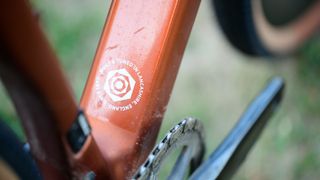
Design and aesthetics
If you find yourself on the Ribble web page browsing models, it's immediately obvious that the design of the Gravel SL positions the bike as the Gravel race bike. The deeper you dig though, the less clear that actually is. There's a confusing jumble of options and some lack of adherence to modern understandings of gravel bike offerings.
If you start with the idea that you are looking for a gravel bike, you'll find three options from Ribble. For the budget focused, you'd want to start with the Ribble Gravel AL. It's an aluminium frame with mounts galore and a price that's going to be difficult to beat. If you've got more money to spend, and your focus is off-road adventure, Ribble offers the Gravel Ti. You'll still get plenty of mounts but in Ti the tubing takes on a classic round shape and there's a carbon fork to help smooth the ride. That leaves the Gravel SL as the race focused gravel model.
As the race focused gravel model, the Ribble Gravel SL takes on much of what you'd expect from a modern gravel race bike. That means, as with almost all modern gravel race bikes, a Toray T1000/T800 carbon monocoque construction that helps keep weight down. What it also means though is an aesthetic style that fits the perception.
In fact, aesthetically, the Gravel Sl feels a bit like a greatest hits of modern gravel race bikes. The all-important aero-esque dropped set stays are present at the rear of the bike and the seat stays are angular throughout the whole length. There's also a dropped drive side chainstay to accommodate tyres as large as 700x45mm or 650x47mm and a large downtube. Additional aero details include some filling in of the main triangle behind the headtube and a rounded inner corner to make room for a D-shaped seat post with a hidden seat post bolt using a wedge. There's even fully internal routing possible depending on build options and there's a gorgeous satin copper paint covering everything. From afar, the profile is undoubtedly that of a modern aero gravel racer.



The geometry though is a bit less extreme than the look. The BMC Kaius 01 is one of the more focused gravel race bikes we've seen of late and, as expected, the numbers for that bike show that it's longer and lower with a much shorter chainstay. To find numbers that look a bit more like what Ribble has used you'll want to look at bikes like the Trek Checkpoint and Canyon Grizl CF. Both of those are stable all-around gravel bikes and you'll find similar chainstay lengths as well as similar head-tube angles.
The first place where the design starts to stray from many gravel race bikes is in the mounts available. While Trek and Canyon drop mounts on the racier build options - and bikes like the BMC Kaius, Felt Breed, and Pinarello Grevil never had them - the Ribble Gravel SL includes it all. On the fork, you'll find three braze-ons on each leg for the times when you need to carry everything. The main triangle includes two bottle mounts inside, a third bottle mount under the downtube, and a pair of bento box mounts on the top tube. At the rear of the bike there is a mudguard/fender mount behind the threaded BSA bottom bracket and another pair of mounts at either ends of the seatstays. Although mudguard compatibility is a big selling point for many, it's worth noting you need extra pieces. There's no seatstay bridge so you will need to either add the Ribble bridge or, perhaps, make something that utilises the two upper seatstay mounts.



The build
If there's anything that makes a Ribble what it is, customization would be a contender. It certainly seems as if you can do almost anything when you pick your bike. There are two Shimano 1x11 Di2 builds with house brand Level 5 one piece bar and stem handlebars and Zipp or Mavic wheels. Below that there's a SRAM Rival AXS option that comes with Mavic 650b wheels and separate bar and stem. Then, at the bottom of the lineup are a pair of mechanical GRX builds with Level 5 alloy 650b wheels.
The idea is to start with one of those base builds essentially to pick your groupset. Then move on to picking one of the five sizes available and from there you can start customising. A reasonable upcharge will get you a wide range of colour options and there are options for different wheels and tyres, handlebars and stems, even small details like bar tape have options. At first glance, Ribble is offering an almost custom purchasing experience.
The truth is a little less rosy though. While you can customise nearly everything, what you can't choose is a 2x groupset. The Gravel SL frame has a braze on mount for a front derailleur but there are no 2x build options. What's odd about that choice is that the CGR SL is the exact same frame but without the mounts on the fork, the third bottle mount, and the bento box mount. It leaves gravel race consumers with an odd choice. Do you want to choose a 2x groupset and give up a third bottle mount and a bento box mount? Or do you settle with a 1x build to get not only the typical gravel race mounts but also bikepacking and commuting mounts?
That's not the only odd choice though. The other big oddity is that there are no handlebar options other than 42 cm. It doesn't matter if you choose the one piece bar and stem or any of the other choices, 42 cm is the only width available for the handlebar choices. That holds true no matter the frame size you choose. You also can't go down in spec on the handlebars to save money on an otherwise throw away component. Shimano Di2, for example, is only available with the more expensive integrated bars and you can't select cheaper bars during customization.
Other than those oddities though, the build options are quite good and represent an incredible value. You can choose to buy only a frameset but there is a hefty discount included for the pricing on whatever components you bundle. The reality is that while there's less customization than it seems, the value is so high that it's probably still cheaper to buy a build and sell pieces than start with a frameset.
What I chose to do for my test was to start with the SRAM Rival AXS Enthusiast build. From there I swapped the wheels to a set of Zipp 303s wheels in 700c. I also wanted to see if the high-end integrated bar was a good choice so I added that to the build but left everything else untouched. That put my test build at a final price of $4501.28 / £3595.83 / €4193.77.




Performance
I've spent the first couple of sections of this article being as hard on a brand as I ever get. Ribble calls the Gravel SL a gravel race bike and makes it look like the design is the result of wind tunnel testing. There's no aero data to back that up though and it seems more like the brand is using aero details for style over substance.
On top of that, I find customization process claims dubious. Offering only a single handlebar size across five frame sizes means only a very small group will have the size needed for a correct fit. I happen to fall outside of that group as I ride a size medium but need a 40 cm bar.
That also leaves out the fact that you can't actually do much customization to the build. You might be able to pick your bar tape but you can't pick a 2x12 groupset with mounting points for a third bottle and a bento box. That's a real miss compared to other brands.
All that said, that stuff is marketing. It's not a performance issue. Start by thinking about this bike differently. The Ribble Gravel SL might not be the perfect modern gravel race bike but it is still a quality, budget-friendly, do-anything kind of bike.
The Gravel SL enthusiast build pairs budget electronic shifting in the form of SRAM Rival AXS with a 40t front chainring and a 10-44 rear cassette. That is the gearing I always recommend for most people doing a wide range of riding and it's fairly rare. If you are actually racing for a win, there might be times when 40/10 gearing isn't right. For going fast with friends though, it's plenty. Meanwhile, at the other end, the 40/44 will give strong riders room to stay seated on loose gravel or pack gear onto the many mounts Ribble offers.
That ability to do anything extends to the frame as well. It's fairly stiff and in my time with it, I've spent a good amount of time using it as a road bike with only a switch of wheels. In those situations, I never felt like I was missing a true road bike.
Of course, there’s always a give-and-take to a do-anything frame. Because of that stiffness, the Gravel SL actually handles crisper on the road than off it. Off-road it could benefit from a bit more compliance in the frame. Although it’s capable in both situations, the lack of spring leads to slightly less engaging off-road ride compared to models from Salsa and Trek. In fact, I stopped a bit short of calling the Gravel SL boring the last time I reviewed it, but it starts to touch on that. It's not quite a gravel race bike but it's also not as tall and comfortable as an adventure bike. It's doing a lot but it's not doing everything as well as a more focused bike.
There is also one more consideration with regard to the one-piece bar and stem combo. While it works fine, the internal routing means that Ribble has gone with a straight 1.5" headset. It may never come up as an issue for you but at this point, a 1.125″ to 1.5″ taper is the standard for forks. If you were to consider adding a suspension fork, you'd need to think about this issue. Since the headtube is large enough for the largest part of modern forks there is likely a workaround. Not only that but this is an edge case for sure. Still, it's worth bringing up as any time a brand chooses to go against the standards it adds a layer of complexity. On the upside, the out front mount that pairs with the one-piece bar is better than most proprietary options.




Value
There’s no doubt that the Ribble Gravel SL is a good-value bike. At a base price of $3,337.10 / £2,665.83 / €3,109.13, it’s very difficult to get a bike this capable for less money. It’s not impossible though and it doesn’t help that Ribble adds a little over $300 extra for delivery.
In my first analysis, I pointed out that there are a lot of similarities with the Salsa Warbird but Salsa is an outlier on price. Frame price is very similar but a full Rival AXS build positions the Warbird as a much more expensive proposition. I’ve now spent time with the Warbird and while I find the ride more exciting the price difference is still difficult to get around.
As before, Trek is probably the closest competitor that you'd want to consider. The Trek Checkpoint SL 6 AXS offers all the same mounts and the same tyre clearance options. The Trek though has storage in the frame, the iso speed decoupler for extra compliance at the rear, and plastic protection for the downtube. Ultimately the extra compliance in the frame makes for a more engaging ride from the Checkpoint but like the Warbird, it’s enough extra money that it’s difficult to say it’s worth it.
Then there's Canyon. Ribble and Canyon are both direct to consumer so the comparison makes sense. The first time I looked at this comparison, Ribble looked like a better value but seven months later, things have changed. There is now a Grizl CF SL 7 eTap with the same gearing and SRAM Rival AXS. There’s no proprietary handlebar required and you get the same available mounts plus there’s a set of mudguards/fenders available. Canyon charges less for that bike plus there’s no delivery fee.
Another direct consumer option worth considering is Ventum. The Ventum GS1 is a more focused gravel race bike and it only has the mounts you need for long-distance gravel racing. If that’s what you are looking for though, it offers SRAM UHD compatibility and an SRAM Apex AXS build, exactly the same as Rival, for less money than Canyon or Ribble. This isn’t a bike I’ve ridden yet but if I was in the market for a budget gravel racer, Ventum would be on the shortlist.





Verdict
It's been seven months since the first time I reviewed the Ribble Gravel SL. At the time I'd ridden it rather extensively on the road and I'd taken it for a number of long off-road winter rides. I loved that it was a bike you could do almost anything on even if it wasn't the most exciting bike to ride. At the time, any deficiencies were easy to waive away when it came time to add up the price and look at the value offered. Since then, things have changed a bit.
The Ribble Gravel SL isn't a focused bike. It does a lot of things and doesn't excel in any one area. At the same time, it offers a lot less customization than it would seem. All of that isn't an issue as long as it's also a great budget option. I much prefer the ride of the Salsa Warbird and the features of the Trek Checkpoint but with both being quite a bit more money, it's hard to argue it's worth it. When the Gravel SL is the cheapest bike around, it's great. it's not the cheapest anymore though.
Unfortunately for Ribble both Canyon and Ventum have evolved over the summer. You can get almost the same bike from Canyon for less money. On the other hand, if you actually want a gravel race bike then you can get one from Ventum for even less money. The Ribble Gravel SL is a capable bike I’d be happy to own but it’s also a bike that competes on price and now there are cheaper options.
| Design and aesthetics | For colour you only get a single choice without paying more. I’m a big fan, you might not be but that is similar to Trek so it’s hard to complain. As far as the actual shape it’s an aero look and I’m a fan. | 8/10 |
| Build | You can customise things a lot but there are also weird limitations. At a bare minimum there needs to be more options for handlebar width. Pricing for what you get is favourable though and even upgrade pricing is better than buying separately. | 7/10 |
| Performance, handling and geometry | A solid B at doing a lot of things. No standout details but also no major detractors. | 8/10 |
| Weight | Once again, a solid B. It’s not a standout but it matches the weight of the competition. | 8/10 |
| Value | Although this is a budget bike, there are now less expensive bikes that are at least as capable. Price is still good but it’s been undercut. | 9/10 |
| Overall | Row 5 - Cell 1 | 76% |
Josh hails from the Pacific Northwest of the United States but would prefer riding through the desert than the rain. He will happily talk for hours about the minutiae of cycling tech but also has an understanding that most people just want things to work. He is a road cyclist at heart and doesn't care much if those roads are paved, dirt, or digital. Although he rarely races, if you ask him to ride from sunrise to sunset the answer will be yes. Height: 5'9" Weight: 140 lb. Rides: Salsa Warbird, Cannondale CAAD9, Enve Melee, Look 795 Blade RS, Priority Continuum Onyx
Most Popular


